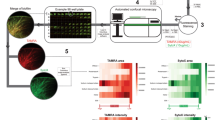Abstract
A wide range of techniques, including high-throughput DNA sequencing methods, have been applied to the evaluation of the normal intestinal flora. However, the inability to grow many of those species in culture imposes substantial constraints on the techniques used to evaluate this important community. The presence of biofilms in the normal gut adds further complexity to the issue. In this study, a flow cytometric analysis was used to separate intact bacterial cells, cell debris, and other particulate matter based on bacteria-specific staining and particle size. In addition, an analysis of biofilm formation using fluorescent light microscopy was conducted. Using these approaches, the ratio of bacterial cell debris to intact bacterial cells as a measure of spontaneous lysis of bacterial cells in the gut of the Cape dune mole-rat (Bathyergus suillus) and the laboratory rabbit (Oryctolagus cuniculus) was examined, and the degree of biofilm formation was semi-quantitatively assessed. The results suggest that the degree of spontaneous cell lysis was greater in the appendix than in the cecum in both the mole-rat and the rabbit. Further, the results point toward extensive epithelial-associated biofilm formation in the proximal mole-rat and rabbit large bowel, although the biofilms may be less structured than those found in laboratory rodents and in humans.








Similar content being viewed by others
References
Bennet NC, Faulkes CG (2000) African mole-rats: Ecology and eusociality. Press syndicate of the University of Cambridge, Cambridge
Berry RJA (1900) The true caecal apex, or the vermiform appendix: Its minute and comparative anatomy. J Anat Physiol 35:83
Björnhag G (1981) The retrograde transport of fluid in the proximal colon of rabbits. Swed J Agric Res 11:63–69
Bollinger RB, Barbas AS, Bush EL, Lin SS, Parker W (2007a) Biofilms in the large bowel suggest an apparent function of the human vermiform appendix. J Theor Biol 249:826–831
Bollinger RB, Barbas AS, Bush EL, Lin SS, Parker W (2007b) Biofilms in the normal human large bowel: fact rather than fiction. Gut 56:1481–1482
Bollinger RB, Everett ML, Wahl S, Lee Y-H, Orndorff PE, Parker W (2005) Secretory IgA and mucin-mediated biofilm formation by environmental strains of Escherichia coli: role of type 1 pili. Mol Immunol 43:378–387
Cork SJ, Hume ID, Fairchney GJ (1999) Digestive strategies of nonruminant herbivores: The role of the hindgut. In: Jung H-JG, Fahey GC (eds) Nutritional ecology of herbivores. American Society of Animal Science, Illinois, pp 210–260
Holtenius K, Björnhag G (1985) The colonic separation mechanism in the guinea-pig (Cavia porcellus) and the chinchilla (Chinchilla laniger). Comp Biochem Physiol 82:537–542
Keith A (1912) The functional nature of the caecum and appendix. Br Med J 2:1599–1602
Kotzé SH, Van Der Merwe EL, Bennett NC, O’Riain MJ (2010) The comparative anatomy of the abdominal gastrointestinal tract of six species of African mole-rats (Rodentia, Bathyergidae). J Morphol 271:50–60
Lee SM, Wyse A, Lesher A, Everett ML, Lou L, Holzknecht ZE, Whitesides JF, Spears PA, Bowles DE, Lin SS, Tonkonogy SL, Orndorff PE, Bollinger RR, Parker W (2010) Adaptation in a mouse colony monoassociated with Escherichia coli K-12 for more than 1,000 days. Appl Environ Microbiol 76(14):4655–4663. doi:https://doi.org/10.1128/AEM.00358-10
Palestrant D, Holzknecht ZE, Collins BH, Miller SE, Parker W, Bollinger RR (2004) Microbial biofilms in the gut: visualization by electron microscopy and by acridine orange staining. Ultrastruct Pathol 28:23–27
Parker W, Thomas AD (2010) Cultivation of epithelial-associated microbiota by the immune system. Future Microbiol 5:1483–1492
Smith HF, Fisher RE, Everett ML, Thomas AD, Bollinger RB, Parker W (2009) Comparative anatomy and phylogenetic distribution of the mammalian cecal appendix. J Evol Biol 22:1984–1999
Swidsinski A, Loening-Baucke V, Lochs H, Hale LP (2005) Spatial organization of bacterial flora in normal and inflamed intestine: a fluorescence in situ hybridization study in mice. World J Gastroenterol 11(8):1131–1140
van der Waaij LA, Mesander G, Limburg PC, van der Waaij D (1994) Direct flow cytometry of anaerobic bacteria in human feces. Cytometry 16(3):270–279
Zoetendal EG, von Wright A, Vilpponen-Salmela T, Ben-Amor K, Akkermans AD, de Vos WM (2002) Mucosa-associated bacteria in the human gastrointestinal tract are uniformly distributed along the colon and differ from the community recovered from feces. Appl Environ Microbiol 68(7):3401–3407
Acknowledgments
The authors would like to thank Dr J. M. O’Riain of the Zoology Department, UCT for kindly donating the mole-rat intestinal tract samples used in this study. This work was supported in part by awards AI-51445, P30 AI 64518, and U19 AI-678547 to the Duke Human Vaccine Institute Research Flow Cytometry Core Facility, and in part by the Fannie E. Rippel Foundation.
Author information
Authors and Affiliations
Corresponding author
Rights and permissions
About this article
Cite this article
Kotzé, S.H., Holzknecht, Z.E., Thomas, A.D. et al. Spontaneous bacterial cell lysis and biofilm formation in the colon of the Cape Dune mole-rat and the laboratory rabbit. Appl Microbiol Biotechnol 90, 1773–1783 (2011). https://doi.org/10.1007/s00253-011-3207-5
Received:
Revised:
Accepted:
Published:
Issue Date:
DOI: https://doi.org/10.1007/s00253-011-3207-5




